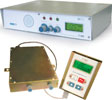

VHF radio communications is still an important part of security alarms.
Security companies have a range of communication options available for monitoring intruder alarm installations today. Technologies include VHF radio, GSM-based systems and spread spectrum equipment. VHF radio has been around for many years and is still one of the primary choices of both small and large security firms.
Each technology has its pros and cons, and each has to be used where most appropriate. Location, functionality and cost all have to be taken into consideration. VHF radio scores highest in terms of affordability. The price of a VHF transmitter unit is less than half of any other comparative technology and there are no data costs involved. The technology also gives complete control over the all important network infrastructure. All communication technologies rely on a network backbone.
With other technologies coming into the market, it would be foolish to only concentrate development efforts on these technologies when VHF radio has so many benefits. RDC recently revealed its latest VHF technology offering (along with its new GSM and spread spectrum products) at IFSEC South Africa SECUREX 2010. The new technology includes a completely new range of transmitters as well as a new network technology called iprs2. The new transmitter range uses a completely new protocol philosophy to transmit alarm signals more efficiently and effectively.
VHF radio transmitters, at every installation in the field, rely on network infrastructure for the safe delivery of alarm signals. The latest iprs2 technology is a step ahead, offering far reaching benefits for demanding and ever growing radio networks. Advanced software uses a new signal routing technology to send data along the most direct path to the base station. Combined with further airtime reduction and a new network protocol philosophy, the system is now more streamlined than ever. The latest offering is ideal for areas with difficult terrain and for high traffic networks.
Network hardware is able to monitor and report on up to four different frequencies with a single unit. The new iprs2 self-test features allow for multiple receivers and other components in the same unit to be tested and reported on individually on an hourly basis. The existing features are still available, including intelligent handshaking and the daisy chain capability, but it is the new routing and protocol innovations that bring VHF alarm communication into a new era.
GSM technology for alarm monitoring offers both GPRS and SMS transmitters for sending signals from an installation to a control room or handset. Here again, backbone infrastructure is critical. Relying on third party networks brings another set of challenges into the picture. To overcome this, RDC’s GSM offerings incorporate enough redundancy to make GSM viable for security monitoring. Multiple networks to fall back on and only the most secure server hosting environments ensure maximum up-time. Spread spectrum technology on the other hand offers superior penetration for difficult installations like basements.
| Tel: | +27 11 452 1471/2 |
| Email: | [email protected] |
| www: | www.radiodata.co.za |
| Articles: | More information and articles about Radio Data Communications |

© Technews Publishing (Pty) Ltd. | All Rights Reserved.